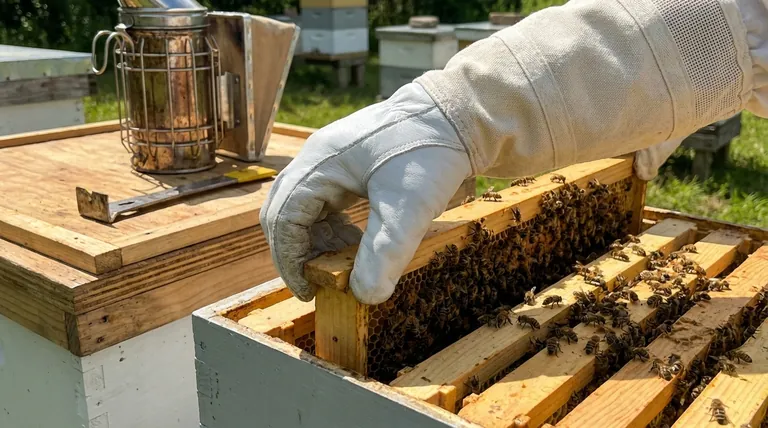The best beekeeping gloves are made from thick, durable materials that provide a critical balance between sting protection and the dexterity required for hive work. Materials like leather, goatskin, and nitrile-coated fabrics are highly recommended, as they are significantly more sting-resistant than thin cotton gloves, which offer insufficient protection.
Your choice of beekeeping glove is not simply about preventing stings; it's about finding the right tool that allows you to work confidently and gently. The ideal glove balances protection with the dexterity needed to handle frames and bees without causing disruption or harm.

Why Your Glove Choice is a Critical Decision
Choosing the right gloves is one of the most important gear decisions a beekeeper makes. It directly impacts your safety, your confidence, and the well-being of your colony.
The Core Purpose: Sting Protection
The primary function of beekeeping gloves is to shield your hands and forearms from stings.
Quality gloves are made of thick, sting-resistant material and have long sleeves, often extending to the elbow, with an elastic cuff to ensure a secure fit. This prevents bees from crawling inside.
The Hidden Need: Dexterity and Feel
While protection is paramount, you must also be able to work effectively. Clumsy, oversized gloves can lead you to accidentally crush bees or damage delicate parts of the hive.
Good gloves allow for the fine motor control needed to lift frames, use hive tools, and perform intricate tasks, which is essential for calm and successful hive inspections.
The Deciding Factor: A Proper Fit
A proper fit is non-negotiable. Gloves should be snug but not tight, allowing for a full range of motion without excess material getting in the way.
Well-fitting gloves dramatically improve your control and reduce the risk of agitating the colony through clumsy movements.
A Breakdown of Common Glove Materials
Each material offers a different combination of protection, flexibility, and durability. Understanding them is key to making an informed choice.
Leather (Cowhide & Goatskin): The Standard for Protection
Leather gloves are a traditional and highly reliable option known for their durability and excellent sting resistance.
Goatskin is often preferred over standard cowhide because it is softer and more flexible, offering a better "feel" while still providing a high level of protection.
Canvas: The Dexterous Option
Canvas gloves are a lighter-weight alternative that offers greater flexibility than most leather options.
They are often suitable for quick, intricate tasks where maximum dexterity is the priority, though they typically offer less sting protection than thick leather.
Nitrile-Coated Gloves: The Modern Hybrid
Nitrile gloves, particularly thicker "exam" style gloves, offer a fantastic balance between protection and feel.
Many beekeepers find they provide enough sting resistance for most situations while allowing for the fine control needed for delicate work.
Understanding the Trade-offs
There is no single "perfect" glove. Your choice will always involve balancing competing priorities.
Protection vs. Dexterity
This is the central trade-off. Thicker, tougher materials like cowhide offer the most protection but the least dexterity. Thinner, more flexible materials like nitrile offer more feel but less resistance to stings.
Durability vs. Feel
High-quality leather gloves are an investment that can last for many seasons. However, their thickness can make it harder to feel what you're doing.
Lighter gloves may provide a better sense of touch but may need to be replaced more frequently.
The Myth of "Sting-Proof"
No glove is truly sting-proof. An aggressive bee can potentially sting through any material. The goal is to find a glove that is highly sting-resistant, giving you the confidence to work calmly and prevent the situations that lead to stings in the first place.
Making the Right Choice for Your Needs
Select your gloves based on your primary goal and comfort level as a beekeeper.
- If your primary focus is maximum protection and confidence: Choose high-quality goatskin leather gloves that offer full forearm coverage and a snug fit.
- If your primary focus is dexterity for intricate tasks: Consider a pair of thick nitrile gloves, understanding they offer slightly less protection than leather.
- If your primary focus is a balance of all factors for general hive work: Goatskin gloves are often the ideal starting point for most new and experienced beekeepers.
Ultimately, the right gloves empower you to work with your bees calmly and effectively, which is the foundation of successful beekeeping.
Summary Table:
| Material | Best For | Key Advantage | Key Consideration |
|---|---|---|---|
| Leather (Goatskin) | Maximum Protection & Durability | Excellent sting resistance, long-lasting | Less dexterity than thinner materials |
| Nitrile-Coated | Dexterity & Fine Control | Great balance of protection and 'feel' | Less protection than thick leather |
| Canvas | Lightweight & Flexibility | Good for quick, intricate tasks | Lower sting resistance |
Equip your apiary with confidence. The right gloves are essential for safe, efficient hive management. At HONESTBEE, we supply commercial apiaries and distributors with high-quality beekeeping gloves and equipment designed for durability and performance. Let our experts help you select the perfect gear for your operation.
Contact HONESTBEE today for wholesale pricing and expert advice on our full range of beekeeping supplies.
Visual Guide

Related Products
- Goatskin Leather Beekeeper Gloves with Vent Long Sleeve for Beekeeping Honey Bee Sting Proof Protection
- Cotton Beekeeping Suit and Round Hat with Veil Bee Keeper Protective Gear
- Mesh Ventilated 3 Layer Goatskin Beekeepers Gloves for Beekeeping
- Economy Polyester Beekeeping Jacket with Veil and Hat
- Beekeeping Jacket with Hood and Veil for Beekeepers
People Also Ask
- What are the characteristics of beekeeping gloves? Balancing Sting Protection with Dexterity
- Why is it important to have gloves available even if not always worn? Essential Risk Management for Beekeepers
- What should beginner beekeepers consider when choosing beekeeping gloves? Balance Protection and Dexterity for Success
- How do beekeeping gloves help in maintaining hygiene? Essential for Hive Biosecurity
- What should be considered when selecting beekeeping gloves? Find the Perfect Fit for Safety & Dexterity



















